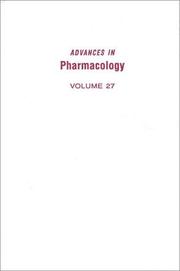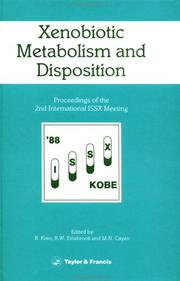| Listing 1 - 10 of 124 | << page >> |
Sort by
|

ISBN: 0120329271 9786611712259 1281712256 0080581188 9780120329274 Year: 1994 Volume: 27 Publisher: New York, NY : Academic Press,
Abstract | Keywords | Export | Availability | Bookmark
 Loading...
Loading...Choose an application
- Reference Manager
- EndNote
- RefWorks (Direct export to RefWorks)
Xenobiotics --- Carcinogenicity. --- Xenobiotics - Carcinogenicity.
Book
Year: 2015 Publisher: Bruxelles: UCL. Faculté de pharmacie et des sciences biomédicales,
Abstract | Keywords | Export | Availability | Bookmark
 Loading...
Loading...Choose an application
- Reference Manager
- EndNote
- RefWorks (Direct export to RefWorks)
Le cheveu est une excroissance épidermique synthétisée dans le follicule pileux. Ses composants principaux sont la kératine (protéine permettant de le structurer), les lipides, et la mélanine (pigment permettant de le colorer). Le cheveu croît d'environ un centimètre par mois, selon un cycle de trois phases : l 'anagène, la catagène et la télogène. Les substances retrouvées dans les cheveux proviennent de leur diffusion active ou passive via trois voies d'entrée : le sang alimentant les follicules, les sécrétions et l 'environnement ; la voie sanguine étant la plus importante. Dans la plupart des cas, ce sont les molécules mères qui s'incorporent dans la matrice. Celles-ci se lient au cheveu via la kératine et la mélanine ; l'eumélanine étant le composé ayant le plus grand pouvoir de liaison des xénobiotiques. L'incorporation des substances dans les cheveux dépend de nombreux facteurs, tels que le contenu en mélanine des cheveux, les caractéristiques de la molécule, les traitements cosmétiques utilisés et les facteurs génétiques. Par exemple, une pigmentation intense des cheveux ainsi que la basicité et la lipophilicité de l'analyte sont corrélés à une bonne incorporation dans la matrice. L'analyse des cheveux est utile dans de multiples domaines, notamment pour évaluer le statut nutritionnel ou la consommation d'alcool de l 'individu, mettre en évidence une exposition fœtale ou lorsqu'une soumission chimique ou un dopage est suspecté. Cet échantillon facilement collecté présente l'avantage d'incorporer les substances de manière stable, pour une longue période. Son analyse permet de mettre en évidence une exposition ancienne et de retracer l' historique d'exposition de la personne sur plusieurs mois/années, en fonction de la longueur des cheveux. Cependant, la quantité limitée d'échantillon disponible ainsi que la faible concentration des substances dans la matrice requièrent l 'utilisation de méthodes analytiques performantes.Les cheveux sont collectés au niveau du vertex postérieur du crâne. Avant l 'analyse, une préparation de l'échantillon est nécessaire , elle se déroule en trois étapes : une décontamination des cheveux, une extraction des analytes d'intérêt et une purification de ceux-ci. L'analyse des cheveux peut se faire par un test préliminaire hautement sensible, souvent une technique immunologique. Néanmoins, chaque résultat positif obtenu doit être confirmé par une méthode plus spécifique, généralement une méthode chromatographique (liquide ou gazeuse) couplée à un spectromètre de masse. Les résultats obtenus doivent être interprétés avec prudence puisque de nombreux facteurs extrinsèques peuvent les influencer (par exemple, l'environnement, les traitements cosmétiques utilisés et l'exposition aux rayons ultraviolets). L'analyse segmentaire des cheveux permet l'estimation du moment d'exposition aux xénobiotiques, celle-ci peut cependant être faussée par les variations de vitesse de pousse des cheveux et la collecte imprécise de l'échantillon. L'interprétation quantitative des résultats reste, quant à elle, compliquée puisque l'existence d'une relation entre la dose de xénobiotique consommée et sa concentration dans les cheveux est controversée. Hair is an epidermal outgrowth synthesized in the hair follicle. Its main components are keratin (a structural material), lipids and melanin (a pigment). Hair grows about one centimeter per month by a three-phase cycle (anagen, catagen and telogen). Substances found in hair result from active or passive diffusion via three incorporation routes: the bloodstream, secretions and external contaminations. In most cases, the parent molecules incorporate in the matrix. Those bind to the hair through melanin and keratin; eumelanin being the substance with the largest binding capacity. Incorporation of drug depends on many factors such as genetic factors, melanin content of hair, chemical properties of the molecule and cosmetic treatments used. Intense hair pigmentation, the basicity and the lipophilicity of the molecule are correlated with a good incorporation. Hair analysis is useful in multiple applications: for example, to assess the nutritional status or the alcohol consumption, to bring out a prenatal exposure and when drug-facilitated crimes or doping are suspected. This sample is easily collected and has the advantage to incorporate xenobiotics for long periods. Its analysis allows to bring out a past exposure and to retrace drug use history. However, the limited amount of sample and the low concentration of substances in matrix require the use of sensitive analytical methods.Hair samples are collected from the posterior vertex of the head. Before analysis, sample preparation is required; it contains three steps: the decontamination of the hair, the extraction of analyzes of interest and their extraction. Hair analysis may consist of a very sensitive preliminary test, an immunoassay. However, each positive result must be confirmed by a more specific method, usually a chromatographic method (liquid or gaseous) coupled to mass spectrometry detector. Results must be interpreted with caution because they may be influenced by a lot of factors (environment, cosmetic treatments and UV exposure, especially). The segmental analysis allows to estimate the period of exposure but the inconsistent collection of samples and the variability in the growth rate may distort results. The quantitative interpretation remains complicated because the existence of a relationship between the xenobiotic dose consumed and its concentration in hair is controversial.
Xenobiotics --- Hair
Book
ISBN: 0841206279 Year: 1979 Publisher: Washington, District of Columbia : American Chemical Society,
Abstract | Keywords | Export | Availability | Bookmark
 Loading...
Loading...Choose an application
- Reference Manager
- EndNote
- RefWorks (Direct export to RefWorks)
Book
Year: 2012 Publisher: [Place of publication not identified] : IntechOpen,
Abstract | Keywords | Export | Availability | Bookmark
 Loading...
Loading...Choose an application
- Reference Manager
- EndNote
- RefWorks (Direct export to RefWorks)
Xenobiotics --- Analysis.
Book
Year: 2012 Publisher: [Place of publication not identified] : IntechOpen,
Abstract | Keywords | Export | Availability | Bookmark
 Loading...
Loading...Choose an application
- Reference Manager
- EndNote
- RefWorks (Direct export to RefWorks)
Xenobiotics --- Analysis.

ISBN: 0850667372 9780850667370 Year: 1989 Publisher: London: Taylor & Francis,
Abstract | Keywords | Export | Availability | Bookmark
 Loading...
Loading...Choose an application
- Reference Manager
- EndNote
- RefWorks (Direct export to RefWorks)
Xenobiotics --- Pharmaceutical Preparations --- Drug Toxicity --- Xenobiotics
Book
ISBN: 0841211086 Year: 1985 Publisher: Washington, D.C. : American Chemical Society,
Abstract | Keywords | Export | Availability | Bookmark
 Loading...
Loading...Choose an application
- Reference Manager
- EndNote
- RefWorks (Direct export to RefWorks)
Xenobiotics --- Xenobiotics --- Metabolism --- Metabolism --- Nutritional aspects
Book
ISSN: 00976156 ISBN: 0841210624 Year: 1983 Volume: 234 Publisher: Washington, D.C. : American Chemical Society,
Abstract | Keywords | Export | Availability | Bookmark
 Loading...
Loading...Choose an application
- Reference Manager
- EndNote
- RefWorks (Direct export to RefWorks)
Book
ISBN: 0841211310 Year: 1986 Publisher: Washington, District of Columbia : American Chemical Society,
Abstract | Keywords | Export | Availability | Bookmark
 Loading...
Loading...Choose an application
- Reference Manager
- EndNote
- RefWorks (Direct export to RefWorks)
Dissertation
Abstract | Keywords | Export | Availability | Bookmark
 Loading...
Loading...Choose an application
- Reference Manager
- EndNote
- RefWorks (Direct export to RefWorks)
| Listing 1 - 10 of 124 | << page >> |
Sort by
|

 Search
Search Feedback
Feedback About UniCat
About UniCat  Help
Help News
News